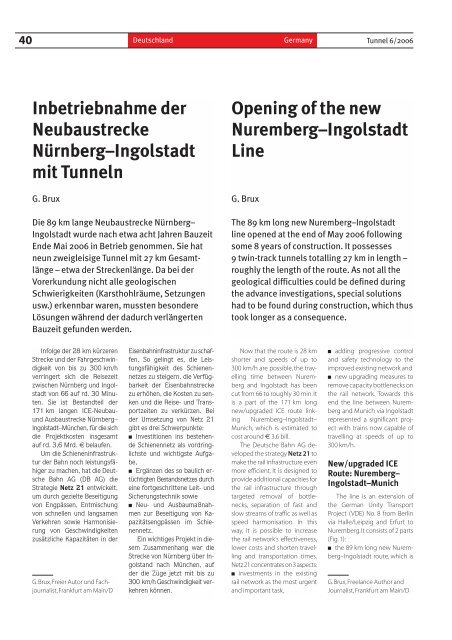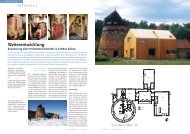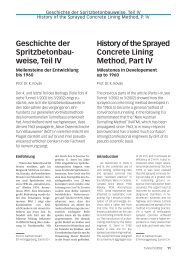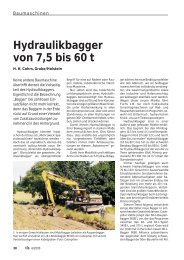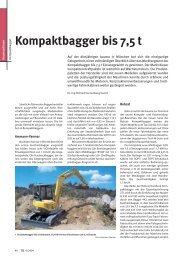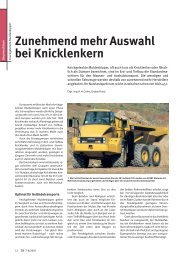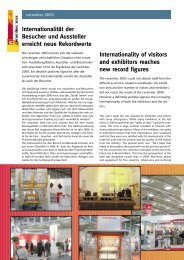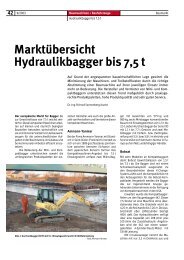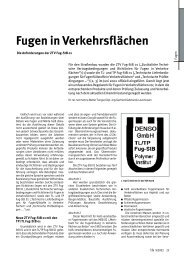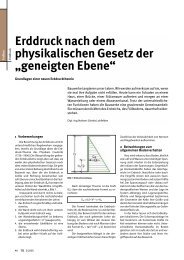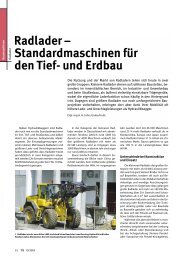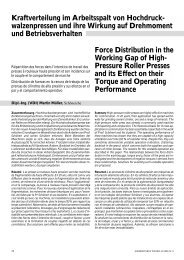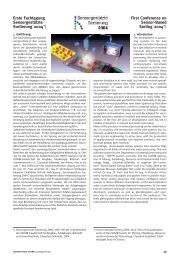Inbetriebnahme der Neubaustrecke Nürnberg ... - Bauverlag
Inbetriebnahme der Neubaustrecke Nürnberg ... - Bauverlag
Inbetriebnahme der Neubaustrecke Nürnberg ... - Bauverlag
Erfolgreiche ePaper selbst erstellen
Machen Sie aus Ihren PDF Publikationen ein blätterbares Flipbook mit unserer einzigartigen Google optimierten e-Paper Software.
40<br />
Deutschland Germany Tunnel 6/2006<br />
<strong>Inbetriebnahme</strong> <strong>der</strong><br />
<strong>Neubaustrecke</strong><br />
<strong>Nürnberg</strong>–Ingolstadt<br />
mit Tunneln<br />
G. Brux<br />
Die 89 km lange <strong>Neubaustrecke</strong> <strong>Nürnberg</strong>–<br />
Ingolstadt wurde nach etwa acht Jahren Bauzeit<br />
Ende Mai 2006 in Betrieb genommen. Sie hat<br />
neun zweigleisige Tunnel mit 27 km Gesamtlänge<br />
– etwa <strong>der</strong> Streckenlänge. Da bei <strong>der</strong><br />
Vorerkundung nicht alle geologischen<br />
Schwierigkeiten (Karsthohlräume, Setzungen<br />
usw.) erkennbar waren, mussten beson<strong>der</strong>e<br />
Lösungen während <strong>der</strong> dadurch verlängerten<br />
Bauzeit gefunden werden.<br />
Opening of the new<br />
Nuremberg–Ingolstadt<br />
Line<br />
G. Brux<br />
The 89 km long new Nuremberg–Ingolstadt<br />
line opened at the end of May 2006 following<br />
some 8 years of construction. It possesses<br />
9 twin-track tunnels totalling 27 km in length –<br />
roughly the length of the route. As not all the<br />
geological difficulties could be defined during<br />
the advance investigations, special solutions<br />
had to be found during construction, which thus<br />
took longer as a consequence.<br />
Infolge <strong>der</strong> 28 km kürzeren<br />
Strecke und <strong>der</strong> Fahrgeschwindigkeit<br />
von bis zu 300 km/h<br />
verringert sich die Reisezeit<br />
zwischen <strong>Nürnberg</strong> und Ingolstadt<br />
von 66 auf rd. 30 Minuten.<br />
Sie ist Bestandteil <strong>der</strong><br />
171 km langen ICE-Neubauund<br />
Ausbaustrecke <strong>Nürnberg</strong>–<br />
Ingolstadt–München, für die sich<br />
die Projektkosten insgesamt<br />
auf rd. 3,6 Mrd. 7 belaufen.<br />
Um die Schieneninfrastruktur<br />
<strong>der</strong> Bahn noch leistungsfähiger<br />
zu machen, hat die Deutsche<br />
Bahn AG (DB AG) die<br />
Strategie Netz 21 entwickelt,<br />
um durch gezielte Beseitigung<br />
von Engpässen, Entmischung<br />
von schnellen und langsamen<br />
Verkehren sowie Harmonisierung<br />
von Geschwindigkeiten<br />
zusätzliche Kapazitäten in <strong>der</strong><br />
G.Brux, Freier Autor und Fachjournalist,<br />
Frankfurt am Main/D<br />
Eisenbahninfrastruktur zu schaffen.<br />
So gelingt es, die Leistungsfähigkeit<br />
des Schienennetzes<br />
zu steigern, die Verfügbarkeit<br />
<strong>der</strong> Eisenbahnstrecke<br />
zu erhöhen, die Kosten zu senken<br />
und die Reise- und Transportzeiten<br />
zu verkürzen. Bei<br />
<strong>der</strong> Umsetzung von Netz 21<br />
gibt es drei Schwerpunkte:<br />
■ Investitionen ins bestehende<br />
Schienennetz als vordringlichste<br />
und wichtigste Aufgabe,<br />
■ Ergänzen des so baulich ertüchtigten<br />
Bestandsnetzes durch<br />
eine fortgeschrittene Leit- und<br />
Sicherungstechnik sowie<br />
■ Neu- und Ausbaumaßnahmen<br />
zur Beseitigung von Kapazitätsengpässen<br />
im Schienennetz.<br />
Ein wichtiges Projekt in diesem<br />
Zusammenhang war die<br />
Strecke von <strong>Nürnberg</strong> über Ingolstand<br />
nach München, auf<br />
<strong>der</strong> die Züge jetzt mit bis zu<br />
300 km/h Geschwindigkeit verkehren<br />
können.<br />
Now that the route is 28 km<br />
shorter and speeds of up to<br />
300 km/h are possible, the travelling<br />
time between Nuremberg<br />
and Ingolstadt has been<br />
cut from 66 to roughly 30 min.It<br />
is a part of the 171 km long<br />
new/upgraded ICE route linking<br />
Nuremberg–Ingolstadt–<br />
Munich, which is estimated to<br />
cost around 7 3.6 bill.<br />
The Deutsche Bahn AG developed<br />
the strategy Netz 21 to<br />
make the rail infrastructure even<br />
more efficient. It is designed to<br />
provide additional capacities for<br />
the rail infrastructure through<br />
targeted removal of bottlenecks,<br />
separation of fast and<br />
slow streams of traffic as well as<br />
speed harmonisation. In this<br />
way, it is possible to increase<br />
the rail network’s effectiveness,<br />
lower costs and shorten travelling<br />
and transportation times.<br />
Netz 21 concentrates on 3 aspects:<br />
■ investments in the existing<br />
rail network as the most urgent<br />
and important task,<br />
■ adding progressive control<br />
and safety technology to the<br />
improved existing network and<br />
■ new upgrading measures to<br />
remove capacity bottlenecks on<br />
the rail network. Towards this<br />
end the line between Nuremberg<br />
and Munich via Ingolstadt<br />
represented a significant project<br />
with trains now capable of<br />
travelling at speeds of up to<br />
300 km/h.<br />
New/upgraded ICE<br />
Route: Nuremberg–<br />
Ingolstadt–Munich<br />
The line is an extension of<br />
the German Unity Transport<br />
Project (VDE) No. 8 from Berlin<br />
via Halle/Leipzig and Erfurt to<br />
Nuremberg.It consists of 2 parts<br />
(Fig.1):<br />
■ the 89 km long new Nuremberg–Ingolstadt<br />
route, which is<br />
G.Brux, Freelance Author and<br />
Journalist, Frankfurt am Main/D
Tunnel 6/2006<br />
NBS <strong>Nürnberg</strong>–Ingolstadt<br />
NBS Nuremberg–Ingolstadt<br />
41<br />
ICE-Neu- und Ausbaustrecke<br />
<strong>Nürnberg</strong>–<br />
Ingolstadt–München<br />
Diese Strecke ist eine Verlängerung<br />
des Verkehrsprojektes<br />
Deutsche Einheit (VDE)<br />
Nr. 8 von Berlin über Halle/<br />
Leipzig und Erfurt nach <strong>Nürnberg</strong>;<br />
sie besteht aus zwei Teilen<br />
(Bild 1):<br />
■ <strong>der</strong> 89 km langen <strong>Neubaustrecke</strong><br />
(NBS) <strong>Nürnberg</strong>–Ingolstadt,<br />
die 28 km kürzer als<br />
die bisherige Strecke ist, und<br />
■ <strong>der</strong> 82 km langen Ausbaustrecke<br />
(ABS) Ingolstadt–München.<br />
Im Vergleich zur früheren<br />
ICE-Verbindung zwischen <strong>Nürnberg</strong><br />
und München über Augsburg<br />
verkürzt sich die Fahrtzeit<br />
über Ingolstadt um rd. 40<br />
Minuten. Auf <strong>der</strong> NBS wurde<br />
bereits Ende Mai <strong>der</strong> Betrieb<br />
aufgenommen.<br />
NBS<br />
<strong>Nürnberg</strong>–Ingolstadt<br />
Zwischen <strong>Nürnberg</strong> und Ingolstadt<br />
besteht jetzt eine<br />
neue zweigleisige Hochgeschwindigkeitsstrecke<br />
für Geschwindigkeiten<br />
bis 300 km/h<br />
für Personenfern- und -nahverkehrszüge<br />
sowie schnelle<br />
Züge des Güterverkehrs. Dazu<br />
ist die NBS auf 75 km Länge –<br />
auch in den Tunneln – in Fester<br />
Fahrbahn (FF) ausgebaut. Die<br />
neue Trasse verlässt südöstlich<br />
von <strong>Nürnberg</strong> bei Feucht die<br />
Bahnlinie <strong>Nürnberg</strong>–Regensburg.<br />
Sie verläuft überwiegend<br />
neben <strong>der</strong> Autobahn A9 o<strong>der</strong><br />
unterirdisch in Tunneln. Im<br />
Nordbahnhof von Ingolstadt<br />
fädelt die NBS dann in die<br />
Bahnlinie Treuchtlingen–Ingolstadt<br />
ein. Im Rahmen <strong>der</strong> Baumaßnahmen<br />
entstanden in Allersberg<br />
(Rothsee) und Kinding<br />
(Altmühltal) Regional- und<br />
Überholbahnhöfe. Außerdem<br />
wurde <strong>der</strong> Regional- und Güterbahnhof<br />
Ingolstadt-Nord als<br />
1 Streckenverlauf <strong>der</strong> Neubau-/Ausbaustrecke <strong>Nürnberg</strong>–Ingolstadt–München<br />
(Grafik:DB Projekt Bau)<br />
1 Alignment of the new/upgraded Nuremberg–Ingolstadt–Munich line<br />
(Graphics:DB Projekt Bau)<br />
dritter Haltepunkt für den Regionalverkehr<br />
ausgebaut.<br />
Tabelle:Tunnel <strong>der</strong> NBS <strong>Nürnberg</strong>–Ingolstadt<br />
Table:Tunnels on the new Nuremberg–Ingolstadt line<br />
28 km shorter than the previous<br />
one – and<br />
■ the 82 km long upgraded<br />
route between Ingolstadt and<br />
Munich.<br />
In comparison to the former<br />
ICE connection between Nuremberg<br />
and Munich via Augsburg,<br />
the travelling time has<br />
been cut by some 40 min. The<br />
route became operational at<br />
the end of May 2006.<br />
New Nuremberg–<br />
Ingolstadt Route<br />
There is now a new twintrack<br />
high-speed line designed<br />
for speeds of up to 300 km/h for<br />
long-distance and regional<br />
services as well as fast goods<br />
trains between Nuremberg and<br />
Ingolstadt.Towards this end,the<br />
new route is provided with a<br />
slab track over a length of 75 km<br />
– also in the tunnels. The new<br />
line veers off from the Nuremberg–Regensburg<br />
route at<br />
Feucht south-east of Nuremberg.<br />
It mainly runs alongside<br />
the A9 motorway or in tunnels<br />
un<strong>der</strong>ground.At the Nordbahnhof<br />
in Ingolstadt the new line<br />
then links up with the Treuchtlingen–Ingolstadt<br />
route. Regional<br />
and overtaking stations<br />
were set up at Allersberg (Roth-<br />
Tunnel An- und Länge Bauweise Geologie im GW Rettungs-<br />
Durchschlag (Karst) ausgänge<br />
Start-up/ Length Construction Geology in GW Rescue exits<br />
breakthrough method (Karst)<br />
[m]<br />
Göggelsbuch 5/1999–4/2000 2288 bergm./Mined 1) ja/yes 1<br />
Offenbau 5/2002–2004 1331 offen/<br />
Cut-and-cover 2) ja/yes 1<br />
Euerwang 6/1999–5/2001 7700 bergm./Mined 1) ja/yes 7<br />
Schellenberg –12/2000 650 bergm./Mined 3) nein/no –<br />
Irlahüll 6/1999–11/2000 7260 bergm./Mined x z.T./partly 6 (9)<br />
Denkendorf 4/2002–4/2003 1925 offen/<br />
Cut-and-cover 2) nein/no 1<br />
Stammham 5/1999–7/2000 1320 bergm./Mined 1) x nein/no 1<br />
Geisberg 3/1999–5/2000 3289 bergm./Mined 1) x z.T./partly 2<br />
Audi 8/2000–10/2001 1258 offen/<br />
Cut-and-cover ja/yes 4<br />
Im Portalbereich z.T.auch kurze Strecken in offener Bauweise/In the portal area in some cases short sections produced by cut-and-cover<br />
1) Spritzbetonbauweise/NATM<br />
2) Deckelbauweise mit Druckluft/Top cover method with compressed air<br />
3) in Deckelbauweise begonnen/Started with the top cover method
42<br />
Deutschland Germany Tunnel 6/2006<br />
Insgesamt entstanden neun<br />
zweigleisige Tunnel (Tabelle)<br />
mit rd. 27 km Gesamtlänge<br />
[1], was etwa 1/3 <strong>der</strong> Streckenlänge<br />
entspricht (Bild 2).<br />
Sechs Tunnel wurden in bergmännischem<br />
Vortrieb in Spritzbetonbauweise<br />
(22 507 m) aufgefahren<br />
(Bild 3) und zweischalig<br />
mit Abdichtung [2] ausgebaut<br />
(Bild 4), drei wurden in<br />
offener Bauweise (4528 m)<br />
ausgeführt – entwe<strong>der</strong> zwischen<br />
Böschungen o<strong>der</strong> in<br />
Deckelbauweise –, zum Teil<br />
unter Druckluft (Bild 5). Je<strong>der</strong><br />
<strong>der</strong> beiden längsten Tunnel<br />
(Euerwang- und Irlahüll-Tunnel<br />
bei Durchquerung <strong>der</strong><br />
Fränkischen Alb) ist über 7 km<br />
und <strong>der</strong> kürzeste (Tunnel Schellenberg)<br />
650 m lang. Die größten<br />
Überlagerungen schwanken<br />
zwischen rd. 5 m beim<br />
Tunnel Offenbau und rd. 190 m<br />
beim Tunnel Euerwang.<br />
Bautechnich war die NBS<br />
von Schwierigkeiten geprägt,<br />
da bei <strong>der</strong> Vorerkundung für<br />
den Tunnelbau nicht alle geo-<br />
2 NBS <strong>Nürnberg</strong>–Ingolstadt – Längsschnitt mit Tunnelbauwerken und Loseinteilung (Grafik:DB Projekt Bau)<br />
2 New Nuremberg–Ingolstadt line – longitudinal section with tunnels and division of contracts<br />
(Graphics:DB Projekt Bau)<br />
Tunnelbauwerke<br />
logischen Schwierigkeiten erkennbar<br />
see) and Kinding (Altmühltal)<br />
waren; so mussten within the scope of these con-<br />
■ <strong>der</strong> Tunnel Offenbau im struction measures.Furthermore<br />
Baulos Nord wegen erkennbarer<br />
the Ingolstadt-North regional and<br />
Setzungen in Deckelbau-<br />
goods station was upgraded as<br />
weise – Baugrube aus seitlichen<br />
a third stop for regional traffic.<br />
Bohrpfahlwänden mit<br />
Spritzbetonausfachung – mit<br />
Bodenaushub und Einbau eines<br />
Tunnels<br />
Sohlgewölbes unter Druck-<br />
Altogether 9 twin-track tun-<br />
luft bei voller Aufrechterhaltung<br />
nels (Table) were produced<br />
des Grundwasserspiegels with an overall length of some<br />
[3] ausgeführt werden (Bild 5), 27 km [1],which corresponds to<br />
3 Die NBS-Trasse führt geradlinig durch den Schellenberg<br />
(Foto – Luftbild:DB Projekt Bau)<br />
3 The new route runs in a straight line through the Schellenberg<br />
(Photo – aerial view:DB Projekt Bau)<br />
roughly 1/3 of the route length<br />
(Fig. 2). Six tunnels were driven<br />
by mining means using the<br />
NATM (22,507 m) and lined with<br />
2 shells and a seal [2] (Fig. 4).<br />
Three were produced by cutand-cover<br />
either between embankments<br />
or by the top cover<br />
method – partly un<strong>der</strong> compressed<br />
air (Fig. 5). Each of the<br />
2 longest tunnels (the Euerwang<br />
and Irlahüll tunnels passing<br />
through the Franconian Alb)<br />
is more than 7 km long and the<br />
shortest (Schellenberg Tunnel)<br />
650 m long. The greatest overburdens<br />
fluctuate between<br />
around 5 m for the Offenbau<br />
Tunnel and roughly 190 m for<br />
the Euerwang Tunnel.<br />
Technically speaking the<br />
new route involved certain difficulties<br />
as it did not turn out to<br />
be possible to identify all geological<br />
problems in advance, as<br />
a result of which:<br />
■ the Offenbau Tunnel in the<br />
northern contract section had<br />
to be tackled by the top cover<br />
method – with a construction<br />
pit with side drilled piling walls<br />
supported with shotcrete –<br />
with soil excavation and the installation<br />
of a base invert un<strong>der</strong><br />
compressed air on account of<br />
recognisable settlement whilst<br />
still completely retaining the<br />
groundwater table [3] (Fig.5),<br />
■ changes had to be made to<br />
the Irlahüll Tunnel project in the<br />
central contract section on account<br />
of karst phenomena,something<br />
which led to consi<strong>der</strong>able<br />
delays in construction and<br />
■ the Denkendorf Tunnel in<br />
the southern contract section,<br />
which was originally planned to<br />
be 670 m long, had to be extended<br />
to 1,925 m in or<strong>der</strong> to<br />
avoid complex embankment<br />
supporting work in a neighbouring<br />
cutting directly alongside<br />
the A9 motorway (Fig.6).<br />
Karst Problems<br />
Karst cavities occur in water<br />
soluble rocks as a result of in-
Tunnel 6/2006<br />
NBS <strong>Nürnberg</strong>–Ingolstadt<br />
NBS Nuremberg–Ingolstadt<br />
43<br />
■ im Tunnel Irlahüll im Baulos<br />
Mitte wegen Karsterscheinungen<br />
Projektän<strong>der</strong>ungen vorgenommen<br />
werden, die zu erheblichen<br />
Bauzeitverzögerungen<br />
geführt haben, und<br />
■ <strong>der</strong> ursprünglich 670 m lang<br />
geplante Tunnel Denkendorf<br />
im Baulos Süd auf 1925 m verlängert<br />
werden, um aufwändige<br />
Böschungssicherungen in<br />
einem benachbarten Einschnitt<br />
unmittelbar neben <strong>der</strong> Autobahn<br />
A9 zu vermeiden (Bild 6).<br />
Karstproblematik<br />
Karsthohlräume entstehen in<br />
wasserlöslichen Gesteinen durch<br />
den unterschiedlichen Abfluss<br />
von Oberflächenwasser; zur<br />
Verkarstung neigen vorrangig<br />
Gebirge mit Vorkommen von<br />
Kalkstein, Dolomitstein und<br />
Gips. Karsthohlräume stellen<br />
ein Risiko dar und können die<br />
Sicherheit von Verkehrswegen<br />
beeinträchtigen (Bild 7). Die in<br />
den Tunneln Irlahüll, Stammham<br />
und Geisberg vorgefundenen<br />
Karsthöhlen erfor<strong>der</strong>ten<br />
um die vorgetriebenen<br />
Tunnelröhren eine Karsterkundung<br />
und -sanierung.<br />
Alle angetroffenen Hohlräume<br />
zogen sich meist spaltenförmig<br />
durchs Gebirge; <strong>der</strong> größte<br />
(im Irlahüll-Tunnel) umfasste<br />
rd. 1000 m 3 . Diese Hohlräume<br />
wurden verfüllt und mit<br />
4 Tunnel Göggelsbuch. Betonieren <strong>der</strong> Innenschale des in Spritzbetonbauweise<br />
aufgefahrenen Tunnels<br />
(Foto:DB Projekt Bau)<br />
4 Göggelsbuch Tunnel. Concreting of the inner shell of the tunnel driven by<br />
the NATM<br />
(Photo:DB Projekt Bau)<br />
Spritzbeton versiegelt, sodass<br />
immer eine rundum geschlossene<br />
Tunnelröhre besteht [4].<br />
In einigen Fällen verstärkte<br />
man die aus Stahlbeton bestehende<br />
Tunnelinnenschale entsprechend;<br />
so sind zusätzliche<br />
konstruktive Maßnahmen [5]<br />
■ die Verzahnung <strong>der</strong> einzelnen<br />
Blöcke <strong>der</strong> Tunnelinnenschale<br />
miteinan<strong>der</strong> zum Vergleichmäßigen<br />
von Setzungen<br />
und<br />
■ den Auffüllbereich zwischen<br />
Tunnelsohlgewölbe bis Unterkante<br />
Feste Fahrbahn zusammen<br />
mit dem Sohlgewölbe aus<br />
bewehrtem Beton herzustellen.<br />
Aus den bei <strong>der</strong> NBS gemachten<br />
Erfahrungen beim<br />
gressing surface water. Rocks<br />
containing limestone, dolomite<br />
and gypsum are mainly affected<br />
by karstification. Karst cavities<br />
represent a risk and can affect<br />
the safety of transport routes<br />
(Fig.7).The karst cavities located<br />
in the Irlahüll, Stammham and<br />
Geisberg tunnels require the<br />
karsts around the excavated<br />
tunnel tubes to be traced and<br />
filled. All the cavities concerned<br />
are largely column-shaped; the<br />
biggest (in the Irlahüll Tunnel)<br />
was some 1,000 m 3 in extent.<br />
These cavities were filled and<br />
sealed with shotcrete in or<strong>der</strong> to<br />
ensure that a tunnel tube could<br />
be produced with all-round closure<br />
[4]. In some cases, the reinforced<br />
concrete inner shell of the<br />
tunnel was correspondingly reinforced.The<br />
following additional<br />
measures were executed [5]:<br />
■ the individual blocks of the<br />
tunnel inner shell were interlocked<br />
to compensate for settlement<br />
and<br />
■ the filling area between the<br />
tunnel base invert and the upper<br />
edge of the slab track was<br />
produced using reinforced concrete<br />
together with the base invert.<br />
A concept to tackle cases of<br />
this nature [4, 5] was drawn up<br />
on the basis of the findings obtained<br />
in mastering the karst<br />
problems that occurred along<br />
the new route.They relate to:<br />
■ the planning phase prior to<br />
the start of construction (preliminary<br />
investigations),<br />
■ the roughwork phase, excavation<br />
with determined support<br />
and decisions in individual<br />
cases (investigations accompanying<br />
construction) and<br />
■ preparation of the final support,<br />
in several stages if required;<br />
verification of stability<br />
(investigations to assure ongoing<br />
operational safety).<br />
The measures were un<strong>der</strong>taken<br />
following proper clarification<br />
with the Fe<strong>der</strong>al Railway<br />
Office (EBA) [5]. The procedure<br />
can in fact still be improved in<br />
terms of both controlling costs<br />
and scheduling.
44<br />
Deutschland Germany Tunnel 6/2006<br />
Bewältigen <strong>der</strong> Karstproblematik<br />
hat man ein Stufenkonzept<br />
zur Lösung <strong>der</strong>artiger Fälle<br />
erarbeitet [4, 5]; sie betreffen<br />
■ die Planungsphase vor Baubeginn<br />
(Voruntersuchungen),<br />
■ die Rohbauphase, Vortrieb<br />
mit Ausbaufestlegung und<br />
Entscheidungen im Einzelfall<br />
(Baubegleitende Untersuchungen)<br />
und<br />
■ Vorbereitung des endgültigen<br />
Ausbaus, bei Bedarf mehrstufig,<br />
Standsicherheitsnachweis<br />
(Untersuchungen zur Gewährleistung<br />
<strong>der</strong> dauernden<br />
Betriebssicherheit).<br />
Die Maßnahmen wurden nach<br />
rechtzeitiger Abklärung mit<br />
dem Eisenban-Bundesamt (EBA)<br />
ausgeführt [5]. Unter den<br />
Aspekten <strong>der</strong> Kosten- und Terminkontrolle<br />
ließe sich die Vorgehensweise<br />
noch verbessern.<br />
Rettungskonzept<br />
Das Rettungskonzept für<br />
die NBS trägt den topografischen,<br />
umwelttechnischen, wirtschaftlichen<br />
und betrieblichen<br />
Randbedingungen Rechnung;<br />
es ermöglicht gefährdeten Personen<br />
die Flucht in sichere Bereiche<br />
und Fremdrettungskräften<br />
die Gefahrenabwehr.<br />
In jedem Tunnel bestehen Notausgänge<br />
(Bild 8) im Abstand<br />
von höchstens 1000 m, was<br />
einem Fluchtwegabstand von<br />
etwa 500 m entspricht [6]. Es<br />
gibt in den Tunneln insgesamt<br />
28 Notausgänge (siehe Tabelle)<br />
mit<br />
■ 12 Schächten mit rd. 280 m<br />
Gesamthöhe und<br />
■ 25 Stollen zu den Schächten<br />
und Notausgangsstollen mit<br />
rd. 8,1 km Gesamtlänge, davon<br />
sind rd. 6,4 km befahrbar<br />
und rd. 1,7 km begehbar.<br />
Auf die beiden längsten<br />
Tunnel (Euerwang 7700 m<br />
und Irlahüll 7260 m mit Überlagerungen<br />
bis 190 m) entfallen<br />
allein 16 Notausgänge, drei<br />
Schachtbauwerke mit 107 m<br />
5 Tunnel Offenbau in Deckelbauweise mit Druckluftvortrieb (offene Bauweise)<br />
(Zeichnung:DB Projekt Bau)<br />
5 Offenbau Tunnel produced by the top cover method with compressed air<br />
drive (cut-and-cover)<br />
(Drawing:DB Projekt Bau)<br />
6 Tunnel Denkendorf in offener Bauweise:Betonieren des Tunnels – Baugrubenverbau<br />
aus Bohrpfählen mit Spritzbetonausfachung<br />
(Foto:DB Projekt Bau)<br />
6 Denkendorf Tunnel produced by cut-and-cover; concreting the tunnel –<br />
construction trench made of drilled piles supported with shotcrete<br />
(Photo:DB Projekt Bau)<br />
Rescue Concept<br />
The rescue concept for the<br />
new route takes the topographical,<br />
environmental, economic<br />
and operational general conditions<br />
into consi<strong>der</strong>ation. It enables<br />
endangered persons to<br />
escape to safe facilities and outside<br />
emergency services to<br />
tackle incidents. Emergency exits<br />
(Fig. 8) are constructed in<br />
each tunnel at gaps of 1,000 m<br />
at the most, representing an escapeway<br />
of some 500 m [6].<br />
There are altogether 28 emergency<br />
exits in the tunnels (see<br />
Table) with<br />
■ 12 shafts with around 280 m<br />
total height and<br />
■ 25 passages to the shafts and<br />
emergency exits with a total<br />
length of 8.1 km;some 6.4 km of<br />
this total is suitable for vehicles<br />
and some 1.7 km accessible on<br />
foot.<br />
There are no less than<br />
16 emergency exists, 3 shaft<br />
structures with a total height of<br />
107 m in the 2 longest tunnels<br />
(Euerwang 7,700 m and Irlahüll<br />
7,260 m with overbourdens of<br />
up to 190 m) as well as 18 galleries<br />
and cross-passages with a<br />
total length of 7.2 km; some<br />
64 km of this total is suitable for<br />
vehicles and some 800 m accessible<br />
on foot.<br />
The shafts that are less than<br />
30 m in height possess 5.80 m<br />
inner diameter and 1.75 m wide<br />
spiral staircases in or<strong>der</strong> to<br />
climb them;those that are higher<br />
have 8 m inner diameter and<br />
2.30 m wide stairs with a central<br />
lift. The galleries from the running<br />
tunnel to the rescue shafts<br />
up to 150 m long and those up<br />
to 300 m long are accessible on<br />
foot (225 m wide and some 3 m<br />
high), the longer galleries are<br />
suitable for vehicles (5.30 m<br />
wide and 4.30 m high).<br />
The running tunnels possess<br />
at least 1.60 m wide escapeways<br />
with hand rails at both<br />
sides, which ensure that persons<br />
being evacuated reach
Tunnel 6/2006<br />
7 Vortrieb des Firststollens im Nahbereich eines Karsthohlraumes<br />
(Zeichnung:[6])<br />
7 Driving the roof heading in the vicinity of a karst cavity (Drawing:[6])<br />
Gesamthöhe sowie 18 Stollen<br />
und Querstollen mit rd. 7,2 km<br />
Gesamtlänge, davon sind rd.<br />
64 km befahrbar und rd. 800 m<br />
begehbar.<br />
Die Schächte unter 30 m<br />
Höhe haben 5,80 m Innendurchmesser<br />
und zum Ausstieg<br />
1,75 m breite Wendeltreppen,<br />
die mit größerer Höhe<br />
8 m Innendurchmesser und<br />
2,30 m breite Treppenläufe<br />
und mittig einen Aufzug. Die<br />
Stollen vom Fahrtunnel zu den<br />
Rettungsschächten bis 150 m<br />
Länge und die Stollen bis<br />
300 m Länge sind begehbar<br />
(2,25 m breit und rd. 3 m<br />
hoch) ausgeführt, die längeren<br />
Stollen sind befahrbar (5,30 m<br />
breit und 4,30 m hoch).<br />
Die Fahrtunnel haben beidseitig<br />
mindestens 1,60 m breite<br />
Fluchtwege mit Handlauf,<br />
die die Flüchtenden zu den sicheren<br />
Bereichen (Notausgänge<br />
o<strong>der</strong> Portale) führen.<br />
Zur Selbstrettung dient<br />
auch die Fluchtwegkennzeichnung.<br />
Zur Tunnelausrüstung<br />
gehören Tunnelsicherheitsbeleuchtung,<br />
Löschwasserleitungen<br />
und -entnahmestellen sowie<br />
Rollpaletten und ein bei<br />
Rettungsdiensten gebräuchliches<br />
Funksystem (BOS-Funksystem).<br />
safe areas (emergency exits or<br />
portals).<br />
Escapeway markings also<br />
serve evacuation purposes. The<br />
tunnel is equipped with safety<br />
lighting, extinguishing water<br />
lines and hydrants as well as<br />
roller pallets and a radio system<br />
commonly used by emergency<br />
services (BOS radio system).<br />
In or<strong>der</strong> to provide protection<br />
against spalling and to avoid excessive<br />
heating up (> 400° C) of<br />
the supporting reinforcement<br />
in the tunnel ceiling as a constructional<br />
measure the concrete<br />
covering was specified to<br />
be at least 6 cm and a galvanised<br />
N94 matting reinforcement<br />
with 2.5 cm concrete covering<br />
installed close to the surface.<br />
Earthworks and<br />
Construction Materials<br />
Around 22 km of embankments<br />
and 26.8 km of cuttings<br />
(24 %/30 % of the route) as well<br />
as trough structures – some<br />
joining up with the tunnels – altogether<br />
3.2 km in length were<br />
produced for the new route in<br />
or<strong>der</strong> to attain a maximum gradient<br />
of 2 % at the most.In addition,around<br />
20 km of protective
46<br />
Deutschland Germany Tunnel 6/2006<br />
Zum Schutz gegen Abplatzungen<br />
und zum Vermeiden<br />
übermäßiger Erwärmung<br />
(>400 °C) <strong>der</strong> tragenden Bewehrung<br />
in <strong>der</strong> Tunneldecke<br />
wurden als konstruktive Maßnahme<br />
die Betondeckung <strong>der</strong><br />
statischen Bewehrung auf<br />
mindestens 6 cm festgelegt<br />
und eine oberflächennahe verzinkte<br />
Mattenbewehrung N 94<br />
mit 2,5 cm Betondeckung eingebaut.<br />
Erdbau und Baustoffe<br />
Für die NBS wurden rd.<br />
22 km Dämme und 26,8 km<br />
Einschnitte (24 %/30 % Streckenanteil)<br />
sowie 10 Trogbauwerke<br />
– teils an Tunnel anschließend<br />
– mit zusammen<br />
3,2 km Länge ausgeführt, um<br />
eine maximale Steigung von<br />
höchstens 2 % einhalten zu<br />
können. Dazu kommen knapp<br />
20 km Schutzwälle und -wände<br />
– oft auf beiden Seiten.<br />
Insgesamt wurden rd. 16 Mio.<br />
m 3 Erdmassen bewegt und<br />
beim Tunnelbau fielen rd.<br />
4,9 Mio. m 3 Ausbruchmaterial<br />
an. Die deponierten Überschussmassen<br />
betrugen insgesamt<br />
14 Mio. m 3 . Beim Bau<br />
<strong>der</strong> NBS (insbeson<strong>der</strong>e für die<br />
Tunnelbauwerke) wurden rd.<br />
3,7 Mio. m 3 Konstruktionsbeton<br />
und 0,4 Mio. t Betonstahl<br />
verarbeitet sowie 0,4 Mio. lfd. m<br />
Bohrpfähle eingebaut.<br />
Planung, Bauablauf<br />
und Baukosten<br />
Das Projekt NBS/ABS <strong>Nürnberg</strong>–München<br />
über Ingolstadt<br />
wurde 1985 in den<br />
Bundesverkehrswegeplan aufgenommen<br />
und das Raumordnungsverfahren<br />
wurde im Juli<br />
1989 eingeleitet und Ende Mai<br />
1991 abgeschlossen. Im November<br />
1993 ging das Projekt<br />
als vordringlicher Bedarf in das<br />
Bundesschienenwege-Ausbaugesetz<br />
(BSchwAG) ein [1]. Die<br />
Planfeststellungsbeschlüsse in<br />
8 Anlagen von Notausgängen für Tunnel in geschlossener Bauweise (Foto:[6])<br />
8 Emergency exit facilities for tunnels produced by mining means (Photo:[6])<br />
den NBS-Baulosen ergingen<br />
zwischen Anfang April 1994<br />
und Ende Februar 1999. Im<br />
Dezember 1996 wurde die Finanzierungsvereinbarung<br />
zwischen<br />
Bund und Bahn abgeschlossen<br />
und zwei Jahre danach<br />
zwischen dem Freistaat<br />
Bayern und <strong>der</strong> Bahn.<br />
Im September 1998 wurden<br />
die Bauaufträge für die<br />
drei großen Abschnitte Nord,<br />
Mitte und Süd <strong>der</strong> NBS an Generalunternehmer<br />
vergeben;<br />
mit den Bauarbeiten wurde im<br />
Herbst 1998 begonnen. Der<br />
erste Tunnelanschlag fand am<br />
18. Mai 1999 (Tunnel Göggelsbuch)<br />
statt und <strong>der</strong> letzte<br />
Tunneldurchschlag war am<br />
2. Mai 2001 (Tunnel Euerwang);<br />
<strong>der</strong> Tunnelausbau war<br />
im Herbst 2004 beendet. Nach<br />
Ausführung des Oberbaus<br />
(durchgehend geschweißtes<br />
Gleis) im Mai 2005 folgten die<br />
walls and barriers were built –<br />
often at both sides.<br />
Altogether some 16 mill. m 3<br />
of earth was moved and approx.<br />
4.9 mill. m 3 of excavated material<br />
was used in tunnelling.A total<br />
of 14 mill. m 3 of excess material<br />
was dumped. During the construction<br />
of the new line (especially<br />
the tunnels) around<br />
3.7 mill. m 3 of structural concrete<br />
and 0.4 mill.t of reinforcing<br />
steel were installed.<br />
Planning, Course of<br />
Construction and Costs<br />
The new/upgraded Nuremberg–Munich<br />
project via Ingolstadt<br />
was included in the Fe<strong>der</strong>al<br />
Transport Routes Plan in 1985<br />
and the regional planning procedure<br />
was introduced in July<br />
1989 and concluded at the end<br />
of May 1991.In November 1993,<br />
the project was accorded top<br />
priority as part of the legislation<br />
governing Fe<strong>der</strong>al Railway expansion<br />
(BSchwAG) [1].The plan<br />
approval proceedings for the<br />
new route contract sections<br />
were carried out between early<br />
April 1994 and the end of February<br />
1999.In December 1996,the<br />
fe<strong>der</strong>al government and the<br />
railways agreed on the financial<br />
arrangements and 2 years later<br />
this matter was also settled between<br />
the Free State of Bavaria<br />
and the railways.<br />
The contracts for all of the<br />
new line’s 3 major contract sections<br />
North, Central and South<br />
were awarded to general contractors<br />
and construction started<br />
in autumn 1998.The first tunnel<br />
breakthrough took place on<br />
May 18th, 1999 (Güggelsbuch<br />
Tunnel) and the final one was<br />
on May 2nd, 2001 (Euerwang<br />
Tunnel). Tunnelling finally came<br />
to an end in autumn 2004. After
Tunnel 6/2006<br />
technische Ausrüstung <strong>der</strong><br />
NBS, Messfahrten und <strong>der</strong><br />
Probebetrieb bis zur <strong>Inbetriebnahme</strong><br />
am 28. Mai 2006. Die<br />
Arbeiten für die ABS wurden in<br />
drei Baulosen ab Frühjahr<br />
2000 vergeben; die Fernbahngleise<br />
sollen im Sommer 2006<br />
fertig gestellt sein.<br />
Die Projektkosten für die<br />
ICE-Neu- und Ausbaustrecke<br />
<strong>Nürnberg</strong>–Ingolstadt–München<br />
belaufen sich insgesamt auf rd.<br />
3,6 Mrd. 7 – finanziert aus<br />
Mitteln des Bundeshaushaltes,<br />
<strong>der</strong> Europäischen Union (EU),<br />
des Freistaates Bayern und Eigenmitteln<br />
<strong>der</strong> Bahn. G. B.<br />
Literatur<br />
[1] Menius, R.: Die Tunnel <strong>der</strong> <strong>Neubaustrecke</strong><br />
<strong>Nürnberg</strong>–Ingolstadt – Planungsstand.<br />
Tunnel 4/1993, S. 198–<br />
203.<br />
[2] <strong>Neubaustrecke</strong> <strong>Nürnberg</strong>–Ingolstadt.<br />
Tunnel 1/2005, S. 2.<br />
[3] Wegerer, P.; Brasch-Remling, O.:<br />
Tunnel Offenbau in einem hydrologisch<br />
schwierigen Umfeld. Eisenbahntechnische<br />
Rundschau (ETR) 1/2-<br />
2004, S. 30–34.<br />
[4] Wegerer, P.: Bewältigung <strong>der</strong><br />
Karstproblematik bei <strong>der</strong> NBS <strong>Nürnberg</strong>–Ingolstadt.<br />
ETR 4/2003, S. 182–<br />
187.<br />
[5] Maidl, B.: NBS <strong>Nürnberg</strong>–Ingolstadt<br />
– Tunnel Irlahüll – Lösung <strong>der</strong><br />
Karstprobleme. 8. Fachtagung <strong>der</strong><br />
EBA-Sachverständigen, Fulda 15. 2.<br />
2006, 25 Seiten.<br />
[6] ICE-<strong>Neubaustrecke</strong> <strong>Nürnberg</strong>–<br />
Ingolstadt. Compress (VGE, Essen),<br />
11/2005; Entwicklung Rettungskonzepte<br />
Tunnel, S. 17–21.<br />
executing the superstructure<br />
(continuous welded track) in<br />
May 2005, the new route was<br />
provided with the necessary<br />
technical equipment and tests<br />
and trial runs were un<strong>der</strong>taken<br />
until it went into service on May<br />
28th,2006.The work for upgrading<br />
the route was awarded in<br />
3 parts as from spring 2000; the<br />
tracks for long-distance traffic<br />
are scheduled to be ready in<br />
summer 2006.<br />
The project costs for the<br />
new/upgraded ICE route from<br />
Nuremberg to Munich via Ingolstadt<br />
amount to roughly 7 3.6<br />
bill. – financed by funds from<br />
the fe<strong>der</strong>al budget, the European<br />
Union (EU), the Free State<br />
of Bavaria and the railways’ own<br />
resources.<br />
G.B.<br />
Weitere News, Artikel o<strong>der</strong> Informationen<br />
zu aktuellen Projekten finden Sie unter<br />
www.tunnel-online.info


